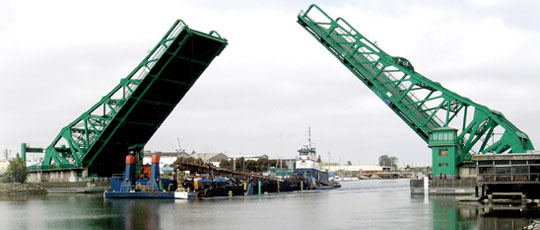One foggy morning around the turn of the 20th century, Seamus McGrath arrived at work drunk. This, according to those who knew him, was not unusual. Seamus was a drawbridge tender, assigned to one of the drawbridges on San Francisco’s busy waterfront.

By Scott Hargis
Published: May, 2006
One foggy morning around the turn of the 20th century, Seamus McGrath arrived at work drunk. This, according to those who knew him, was not unusual. Seamus was a drawbridge tender, assigned to one of the drawbridges on San Francisco’s busy waterfront. As he lit his pipe, he heard a boat’s horn signaling to open the bridge. Weaving slightly, he dutifully lowered the traffic barriers and stepped out of the tower to look for the approaching boat before manually cranking the bridge open. That’s when he dropped his pipe. Lunging for it, but off balance - perhaps from the whisky - Seamus fell off the bridge and drowned.
Things are different, now, in the drawbridge business. For one, drunkenness on the job is not tolerated! And the bridges are no longer manually operated. On the other hand, some things don’t change – boats still sound their horns, traffic must still be stopped and bridge tenders can still tell a few wild stories about boaters and motorists.
Stand clear for bridge opening!
With those words broadcast over the loudspeakers, bridge tender Richard Smid, a 10-year veteran bridge tender, lowers the traffic barriers and prepares to open the Miller-Sweeney Bridge. His eyes are everywhere at once, keeping track of the oncoming boat, watching a lift control panel that contains a mind-boggling array of buttons, dials and gauges, and most of all, watching for cars and pedestrians.
I once had a woman drive her car around the barricade and then panic and stop dead on the bridge. I couldn’t lift the bridge with her car out there, and she didn’t respond when I instructed her over the loudspeaker. I finally had to walk out there, and tell her it was okay to drive on to the other side, said Ken Sequeira, who was a bridge tender for over five years before becoming the Bridge Supervisor.
Other tales include cars that try to beat the bridge by getting across before it starts to lift, or pedestrians who want to ride the bridge up. More than one sailboat has been dismasted when its skipper failed to allow the bridge to lift completely before passing through.
When assured that the bridgeway is clear, Smid works the controls and the massive structure rises smoothly and startlingly quickly into the air. The 2.6-million pound counterweight drops into the pit, which is forty feet below the roadway, and nearly twenty-five feet below the surface of the water.
To climb down the narrow stairway and stand in the pit is an awe-inspiring experience. A huge, empty concrete room, surprisingly clean, it is nonetheless do minated by the massive concrete and steel mass suspended overhead. When I mentioned that this would be no place to stand when the bridge was in operation, Sequeira, who has worked on the drawbridges for 18 years, responded casually, Oh, it’s okay. The weight just swings down and stops right about here. But the image of over two-and-a-half million pounds of concrete swinging towards me at almost a foot per second was still disturbing.
Under the bridge is the electric motor and gearing that operates it. Astonishingly, a pair of 75 horsepower motors is all that is required to operate the bridge. Connected to an impressive array of gears and shafts, these motors move several million pounds of bridge through 79 degrees of arc in only 66 seconds. In fact, should these motors fail, there is a backup motor of only 5-HP that can do the job, albeit more slowly.
What if the power goes out?
The Bridge Division of the Alameda Public Works Agency, which oversees operations on all Alameda bridges, has a portable generator that can be driven and connected to any of the bridges, allowing them to be operated in an emergency. In fact, the bridges of Alameda County survived the 1989 earthquake quite well, with only minor damage that didn’t prevent operations.
Seamus McGrath took his fatal plunge before the Great Earthquake of 1906, so we don’t have his opinion on that event. But it’s safe to say that he’d be suitably impressed with today’s modern drawbridges, if only for the improved safety features.
Alameda County operates six of the last remaining 24-hour bridges in the state. Most are closed to marine traffic during nighttime hours, but since the Oakland-Alameda Estuary still carries a significant amount of commercial shipping, these bridges are staffed and operational 24 hours a day, 365 days of the year.
Alameda has three types of drawbridges:
Vertical lift, Single-leaf bascule, Double-leaf bascule
• Vertical lift bridges have a section that rises straight up from the middle of the bridge deck.
• Single-leaf bascule bridges have only one moving deck, which is “hinged” on one side, and swings up and out of the way.
• Double-leaf bascules operate by separating in the middle, with each side lifting independently.
Photos above: (left) Bridge tender, Richard Smid; (middle) Fruitvale’s single-leaf bascule bridge; (right) Bay Farm Island Bridge — the only drawbridge in the U.S. that is exclusively for pedestrians and bicycles. Photos by: Scott Hargis and Francisco Arreola (second from left).
Photos (opposite): Park Street double-leaf bascule bridge. Photos by: Francisco Arreola
Historical note: Seamus McGrath’s grandnephew, Ed McGrath, grew up to become a well-known yacht dealer, and, along with his wife, Pam, contributes a monthly boating column to Bay Crossings.


